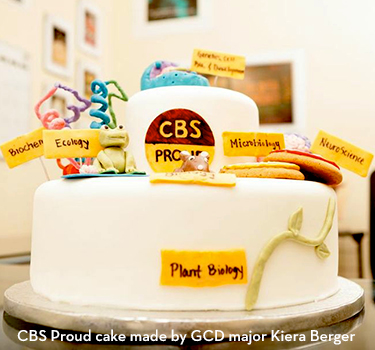Kiera Berger draws inspiration for her confections from everywhere, even her science classes.

| |
Kiera Berger loves science, but her other passion is art. She draws. She paints. And she decorates cakes! The genetics, cell biology and development major talks about how art, science and academics intersect. Q: How does your background in science influence your art and vice versa?Art and science are two of my lifelong passions. I recently realized how much they complement each other. The same qualities that make me a good artist – creativity, problem solving, being a visual learner, and thinking abstractly – also help me think critically and see things from a different perspective in my academic life. I’ve spent my entire life learning drawing, painting, and cake decorating techniques, just as I’ve learned laboratory methods and techniques (using a pipette is eerily similar to using a frosting bag and decorating tip). The overarching idea for both art and science is to produce original work that is appreciated by and useful to others. Q. In addition to drawing and painting, you decorate cakes. How did you get into that?I have been cake decorating since I could hold a frosting bag in my hands. My grandmother passed along her skills to both my mother and me. I decorated cookies with the two of them until my mom helped me join a local 4-H club when I was nine. Through 4-H, I was able to develop my skills and compete every year. My inspiration for a piece or a cake comes from both “light bulb” moments and an admiration for the work of other artists – I even get ideas for my artwork from the visuals in science classes like cell biology. Q: Do you use your artistic background in your courses?I have applied my artistic talents for group work, like when we make posters, and I’m able to use the science illustration programs to make figures look the way I envision the cellular process in my mind. Scientific figures can be really plain or not very easy to understand, so I’m always trying to make my scientific illustrations better. — Diedre Ribbens |
